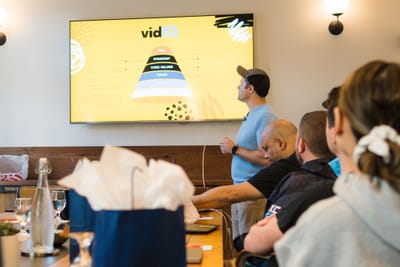Several years ago I was sitting in a Zoom call waiting for a creator to show up. Given how much creators pay for these YouTube consultations, they typically show up early with a pad and pencil, ready to take notes, but 5 minutes had passed and this creator had still not shown up.
I continued to wait. Another 5 minutes went by.
I was about ready to send an email saying, "Sorry we missed each other," but just then I heard the Zoom chime – someone entered the meeting. Switching back to the Zoom window from my email, I noticed she was out of breath and frazzled.
At first I offered the normal greeting. "Hey, how are you?"
She replied, "Hey, good. How are you?" while searching for something on her desk.
I decided to slow down the conversation, sensing that something else was clearly going on. "No really, how ARE you?" I asked.
She immediately stopped. "Oh..." She hesitated for a second and settled into her seat. Her demeanor relaxed. "No one has asked me that for a while."
I was honestly not sure how to respond, so I waited.
A few seconds went by as she gathered her thoughts. Then she proceeded to share about significant life circumstances. Divorce. Abuse. A child custody battle. A successful business. New opportunities. So much to navigate all at once.
After 10 minutes we were back on track and discussing her channel, but I'd find out later that those ten minutes left a lasting impression on her. It turned a normal coaching call into a long-term coaching relationship. As usual, I passed her off to another YouTube coach on our team who helped her turn her channel into one with almost 2 million subscribers.
Sometimes, the most powerful thing we can offer another person isn't our expertise—it's our presence.
Early in my coaching career, I approached each session armed with frameworks and action plans. I was there to solve problems, after all. But something interesting happened when I started paying attention to which conversations actually generated the best results for the creator.
It wasn't the sessions where I delivered the perfect strategy. It was the ones where I truly saw the person in front of me—where I created space for them to be fully heard, to think out loud without judgment, and to connect with their own insights.
The metrics-driven part of me initially resisted this approach. If I wasn't providing solutions, what value was I adding?
But I've come to understand that being fully present—listening beyond words, noticing subtle shifts in attitudes, and reflecting back someone's thoughts while they're processing through them—isn't passive. It's perhaps the most active form of support we can offer.
This principle extends beyond formal coaching relationships. I notice it with my kids—sometimes they don't need me to solve their problems or teach them lessons. They simply need me to put down my phone, make eye contact, and listen with my full attention.
I see it in one-on-ones with my team members who are wrestling through a decision. A simple question followed by attentive listening frequently reveals that they already know what to do.
Even in friendships, I've learned that when someone shares a struggle, starting with, "Here's what you should do," can shut down the very connection they're seeking. Often, they're not looking for solutions—they're looking for connection.
So how do we develop this capacity? Here's what I've found helpful:
- Enter conversations with curiosity rather than conclusions. Wonder more, solve less.
- Pay attention to your listening. Are you fully present or mentally preparing your response while patiently waiting for them to stop talking?
- Ask questions that expand thinking rather than directing it toward your preferred solution... until, of course, your solution is clearly the one they need to discover.
- Reflect back what you hear, helping others hear their own thoughts more clearly and reinforcing that you heard them accurately.
We live in a world where many people feel invisible. Their ideas go unheard, their concerns are dismissed, their emotions are invalidated. The simple act of truly seeing another person—acknowledging their reality and creating space for their experience—can change people's lives.







